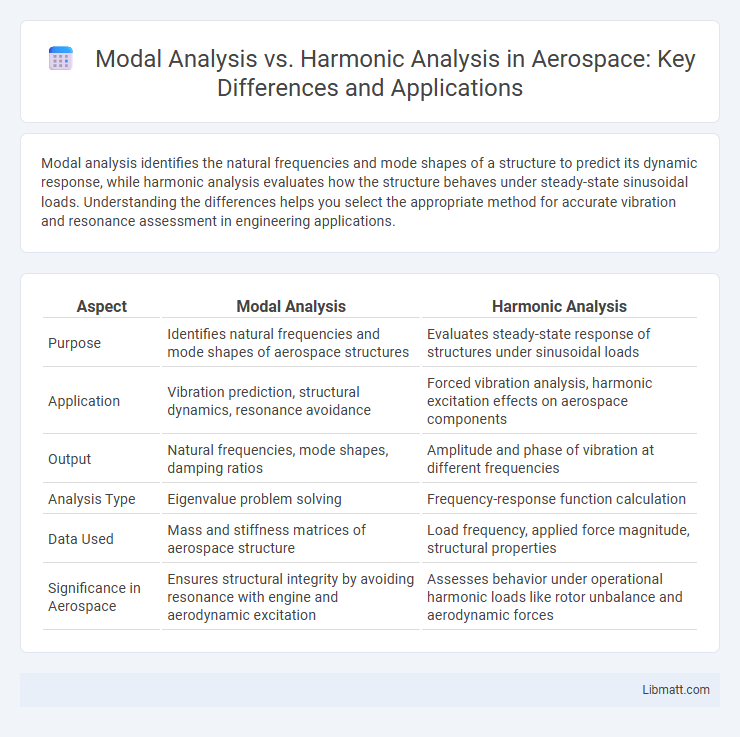Modal analysis identifies the natural frequencies and mode shapes of a structure to predict its dynamic response, while harmonic analysis evaluates how the structure behaves under steady-state sinusoidal loads. Understanding the differences helps you select the appropriate method for accurate vibration and resonance assessment in engineering applications.
Table of Comparison
| Aspect | Modal Analysis | Harmonic Analysis |
|---|---|---|
| Purpose | Identifies natural frequencies and mode shapes of aerospace structures | Evaluates steady-state response of structures under sinusoidal loads |
| Application | Vibration prediction, structural dynamics, resonance avoidance | Forced vibration analysis, harmonic excitation effects on aerospace components |
| Output | Natural frequencies, mode shapes, damping ratios | Amplitude and phase of vibration at different frequencies |
| Analysis Type | Eigenvalue problem solving | Frequency-response function calculation |
| Data Used | Mass and stiffness matrices of aerospace structure | Load frequency, applied force magnitude, structural properties |
| Significance in Aerospace | Ensures structural integrity by avoiding resonance with engine and aerodynamic excitation | Assesses behavior under operational harmonic loads like rotor unbalance and aerodynamic forces |
Introduction to Modal and Harmonic Analysis
Modal analysis evaluates a structure's natural vibration modes and corresponding frequencies to predict its dynamic behavior under various conditions. Harmonic analysis examines the steady-state response of a structure subjected to sinusoidal loads at different frequencies to assess resonant behavior and forced vibrations. Both analyses are essential in engineering to design systems resilient to dynamic forces and optimize performance.
Definitions: Modal Analysis vs Harmonic Analysis
Modal analysis identifies the natural vibration modes and frequencies of a structure or mechanical system by solving eigenvalue problems, revealing its dynamic characteristics. Harmonic analysis examines the steady-state response of a system subjected to sinusoidal loads at varying frequencies, focusing on amplitude and phase of vibrations. Understanding modal analysis provides insight into resonance conditions, while harmonic analysis predicts system behavior under operational excitation frequencies.
Fundamental Principles of Modal Analysis
Modal analysis identifies a structure's natural frequencies, mode shapes, and damping characteristics by solving eigenvalue problems from its mass and stiffness matrices. These fundamental principles enable engineers to predict dynamic behavior under various conditions by decomposing complex vibrations into simpler modal components. Modal analysis forms the basis for designing systems to avoid resonance and improve stability in mechanical, aerospace, and civil engineering applications.
Core Concepts of Harmonic Analysis
Harmonic analysis focuses on determining the steady-state response of a structure subjected to sinusoidal loads, analyzing how the system vibrates at various frequencies. It calculates amplitude and phase of displacements, stresses, and strains to predict resonant behavior and dynamic amplification factors. Your engineering assessments benefit from identifying critical frequencies where harmonic excitation may cause excessive vibrations or structural failure.
Methodologies: Key Differences in Approach
Modal analysis focuses on determining natural frequencies and mode shapes of a structure by solving eigenvalue problems derived from the system's mass and stiffness matrices. Harmonic analysis evaluates the steady-state response of a system under sinusoidal excitation by applying frequency-domain techniques to solve complex equations involving damping, stiffness, and mass properties. The primary methodological difference lies in modal analysis identifying inherent dynamic characteristics without external forces, while harmonic analysis predicts forced vibration behavior across a range of excitation frequencies.
Applications of Modal Analysis
Modal analysis is essential for identifying natural frequencies and mode shapes in structures, which helps predict resonant behavior under dynamic loading conditions. It is widely applied in aerospace engineering for aircraft structural design, automotive industries for vibration reduction, and civil engineering for assessing building responses to seismic activities. This analysis optimizes material usage and enhances safety by preventing resonance-induced failures.
Applications of Harmonic Analysis
Harmonic Analysis is essential for studying the steady-state response of structures and mechanical systems subjected to sinusoidal loads, making it crucial in designing vibration isolators, rotating machinery, and acoustic components. It predicts resonant frequencies and displacement amplitudes under harmonic excitation, helping engineers avoid resonance-related failures. You can apply Harmonic Analysis to optimize damping and ensure structural integrity in automotive, aerospace, and civil engineering projects.
Advantages and Limitations of Each Method
Modal analysis identifies a structure's natural frequencies and mode shapes, enabling prediction of resonance and dynamic behavior, which helps optimize design for durability and performance. However, it assumes linear, undamped systems and cannot directly simulate forced vibrations under real operating conditions. Harmonic analysis models steady-state vibration response to sinusoidal loads, providing insight into amplitude and phase under specific frequencies, but it requires detailed load characterization and can be computationally intensive for complex geometries. Choosing the appropriate analysis depends on your need to understand inherent structural dynamics or actual response under periodic excitation.
Choosing the Right Analysis for Engineering Problems
Modal analysis identifies natural frequencies and mode shapes of structures, essential for predicting resonance and dynamic response in engineering designs. Harmonic analysis evaluates steady-state response under sinusoidal loads, crucial for assessing vibration amplitudes and fatigue risks in operational conditions. Choosing the right analysis depends on whether you need to understand intrinsic vibration characteristics or response to specific frequency excitations.
Future Trends in Structural Dynamics Analysis
Future trends in structural dynamics analysis emphasize integrating advanced computational methods such as machine learning with modal and harmonic analysis to predict complex vibrational behaviors more accurately. Modal analysis continues to evolve with enhanced sensor technology and real-time data processing, enabling more precise identification of natural frequencies and mode shapes. In harmonic analysis, improvements in high-frequency response modeling and adaptive algorithms help you optimize structural designs by capturing nonlinearities and dynamic responses under cyclic loads.
Modal Analysis vs Harmonic Analysis Infographic

 libmatt.com
libmatt.com